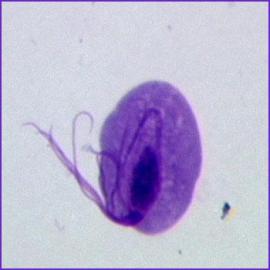Sexually transmitted infection: Trichomonas Vaginalis

Trichomoniasis is a sexually transmitted infection caused by the flagellated protozoan Trichomonas vaginalis. The organism is recognized by the rapid movement, from back to front, generated by four anterior flagella and the undulating membrane. The parasite adheres to the squamous epithelium, interdigitating in the zone of contact with the host cell, cytochalasin B blocks the process by inhibiting the synthesis of the microfilaments. Proteases and other surface antigens are regulated by iron concentration, in correlation with certain changes in virulence. The prevalence of trichomoniasis in specific population groups has been correlated with levels of sexual activity. The prevalence in men is low, explained by the high proportion of asymptomatic cases. Vaginal discharge, itching, dyspareumia, and dysuria have been reported in 50-75% of women diagnosed in primary care settings. Punctual hemorrhages of the cervix usually give it a fresiform appearance, the definitive diagnosis is made with the microscopic demonstration of Trichomonas.
Pathogeny
T vaginalis adheres to the vaginal and urethral epithelium, a process facilitated by the presence of alpha-D-mannose and N-acetiglucosamine existing on the surface of the protozoan; in addition to the proteases capable of digesting fibronectin, collagen IV and hemoglobin, it has several other adhesins.6,7 Trichomonas does not have mitochondria, it has the hydrogenous organelles that perform anaerobic oxidation: glucose is transformed into glycerol plus succinate by action of pyruvate ferredoxin and finally acetate and hydrogen are released. The mobile parasite generates cytopathic damage, by means of certain membrane interdigitations rich in actin microfilaments (mf). Experimentally, the cyto-D calasin inhibits the synthesis of the microfilaments; in this way cytopathogenicity is reduced.8 T. vaginalis does not synthesize lipids, therefore, erythrocytes are the source of fatty acids. Iron is an important nutrient, it regulates the production of proteases. Upon entering the vagina, parasites multiply and induce desquamation of the vaginal epithelium, with infiltration of polymorphonuclear leukocytes, neutrophils, and increased vaginal secretions. The intensity of the infection has been related to the parasite load. In the organism of infected males, the existing zinc concentrations in the semen have a trichonicide effect; but in those with low zinc levels, the parasite persists, causing a carrier of the infection. In pregnant women with high loads of trichomonas, preterm births and low birth weight infants have been described. Although parasitic membrane antigens are immunogenic and induce synthesis of IgA and serum (Ac) antibodies, no correlation has been found between antibody levels and resistance to infection. In the laboratory it has been possible to purify the 30 kDa cysteine proteinase (CP) (adhesin), another 65 kDa cysteine proteinase (cytotoxic) and the 120 kDa adhesin; These antigens are immunogens and have been used to prepare highly specific immunofluorescence reagents.9 Table I presents the prevalence of symptoms and signs in women with trichomoniasis; while Table II summarizes the risk factors.
Treatment

Pharmacotherapy is indicated to eradicate the microorganism in women and their sexual partners. Almost all T. vaginalis strains are susceptible to 1 µg of metronidazole under anaerobic conditions. Administering the oral dose of 500 mg, a serum level of 10 µg / mL is obtained and with the single dose of 2 g, levels of 40 µg are reached. / mL, the cure rate is 82 to 88%. In males, the 250 mg regimen has been used three times a day for seven days. The short single-dose regimen generates fewer side effects and is more likely to be carried out. The results are optimal when simultaneously treating the sexual partner.
You have more questions or you need to know more if you suffer from this disease, visit our blog and stay informed.
Go to our gynecologist to carry out an infectious PCR study
IBQ. Giovanni Santiago Casas
Responsable of Genétic Unit at Irega Acapulco
Referencias
1.Teodoro Carrada-Bravo. Educación Médica e Investigación. Hospital General de Zona y Medicina Familiar 2, Delegación Guanajuato, Instituto Mexicano del Seguro Social.

